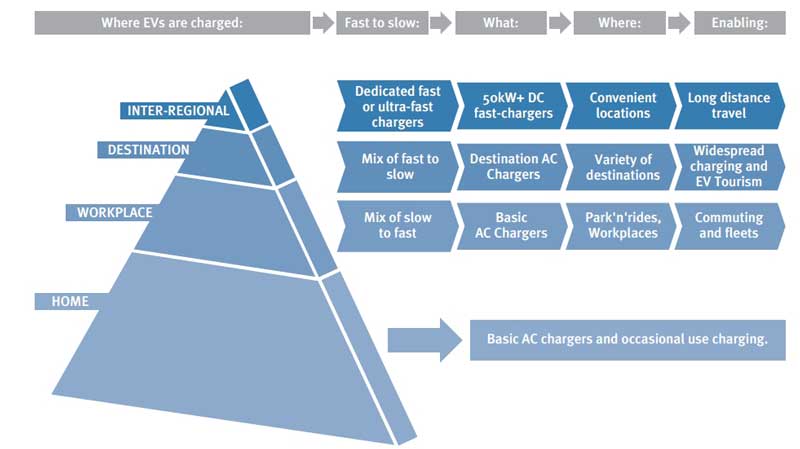This weekend saw some further announcements on how the Victorian Government plan to spend the $100 million allocated in the last state budget to their Zero Emissions Vehicle Roadmap.
These new announcements include:
- $5 million for a fast-charging network;
- $3 million in new charging grants for local council and business fleets and
- Streamlining of the $3000 EV subsidy program.
The fast-charging announcement will add a further 141 fast-charging stations to the recently completed first stage of the ‘Charging the Regions’ project (comprising over 20 DC fast-chargers of 25 – 50kW spread around regional Victoria).
However, the announcement did not detail whether these new chargers will be proper Level 4 DC fast chargers (generally 50kW to 350kW), or merely Level 3, 7 to 22kW AC chargers.
Level 4 chargers are what is needed to facilitate easy regional travel in EVs as they add 100km extra driving range in times as low as five to 14 minutes (depending on the car and DC charger size).
On the other hand, for most current model EVs – AC chargers will return 100km of charge in around 2 hours. Such Level 3 AC chargers are excellent for local travel top-ups, but inadequate to meet the needs of regional travellers, tourists and tradies. As shown in figure 1, whilst DC chargers are only needed in small numbers, they are key to a proper EV charging network.

Figure 1: EV Charging Infrastructure Hierarchy
Going by the numbers (141 chargers and $5 million dollars) the investment per charger is around $35,500 per charger (less if deducting program administration and the like costs).
This would not seem adequate for a proper DC network of 50kW and above chargers, as being installed in other states such as NSW and Tasmania.
If the announcement covers mainly Level 3 AC charging – then regional Victorians would be rightly disappointed at this lack of proper investment in EV charging. The Driven will be reaching out to the Victorian Government to get further detail on this aspect of the announcement.
The second part of the announcement ($3 million in new charging grants for local council and business) should be welcomed by both. Many local councils are already planning to move most, if not all of their fleets to ZEVs within 10 years, so the time to plan and install EV charging is now.
Boosting available funding to EV charger installations as these fleet change-overs are being planned is welcome timing.
For business, the economics of replacing fossil fuelled vehicles by ZEVs has been tipping inexorably in favour of ZEVs, so business will welcome the signal being given by the state government that ZEVs are a better choice over fossil fuelled vehicles.
This may help many businesses over the line to choosing ZEV earlier than they currently intended. Such EV charging grants and subsidies for businesses will be particularly cost-effective in new commercial and retail developments where the cost of installing EV charging during construction is significantly lower than retrofitting it afterwards.
However, other states are already moving on developing plans and legislation to support defining and mandating ‘EV Ready Developments’ in new and redeveloped buildings – yet the Victorian Government’s announcement seems more to be fiddling around the edges as there appears to be no solid plan behind it to embed EV charging in the future planning and design thinking of developers and building owners.
The third part of the announcement – streamlining the $3000 EV subsidy payment process to ZEV buyers – addresses anecdotal reports I have received that the current one is very difficult to navigate and places many seemingly unnecessary hurdles involving layers of paperwork and process to be completed before receiving it.
Buyers will welcome the move of the payment process onto car dealers to sort – although car dealers may not be quite so supportive of the change!
So are these announcements the major ZEV advances as they are trumpeted to be in this weekend’s press releases? Quoting from the very beginning of the Victorian Government’s own Victoria’s Zero Emissions Vehicle Roadmap document:
“Victoria’s transport sector accounts for 25 per cent of Victoria’s carbon emissions. Transitioning to zero emissions vehicles (ZEVs) will help Victoria reach net-zero emissions, but there’s no time to waste. It will take 25 years for the community and industry to fully transition to ZEVs. That is why Victoria needs to act now to fully transition to ZEVs before 2050.”
Reviewing the latest announcements – compared to the moves by other states (NSW, Tasmania and the ACT in particular) the new Victorian Government ZEV announcements seem quite piecemeal and altogether not forward thinking enough to meet the urgency it purports to be in support of.

Bryce Gaton is an expert on electric vehicles and contributor for The Driven and Renew Economy. He has been working in the EV sector since 2008 and is currently working as EV electrical safety trainer/supervisor for the University of Melbourne. He also provides support for the EV Transition to business, government and the public through his EV Transition consultancy EVchoice.

